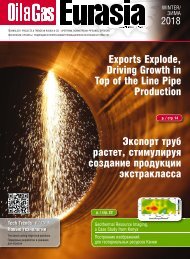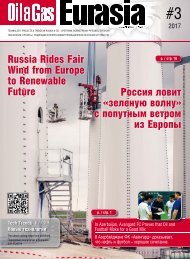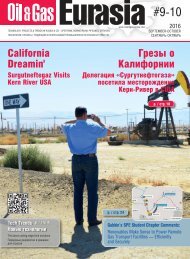You also want an ePaper? Increase the reach of your titles
YUMPU automatically turns print PDFs into web optimized ePapers that Google loves.
№1 <strong>2017</strong><br />
ЛАРН<br />
● Table 1 - Advantages and disadvantages of in-situ burning<br />
● Таблица 1 - Преимущества и недостатки сжигания нефти на месте<br />
Advantages / Преимущества<br />
Efficient and rapid removal of large quantities of oil from the sea surface. The<br />
duration of burning does not exceed 1 hour. With proper application and<br />
under favorable conditions, less than 5% of the spilled oil remains in the sea. /<br />
Эффективное и быстрое удаление большого количества нефти с поверхности<br />
моря. Продолжительность сжигания не превышает 1 часа. При правильном<br />
применении и при благоприятных условиях в море остается менее 5%<br />
разлитой нефти.<br />
Much less, in comparison with the mechanical oil collection, requirements<br />
for equipment, logistics and storage. / Намного меньшие, по сравнению с<br />
механическим сбором нефти, требования по оборудованию, логистике и<br />
хранению.<br />
Significantly reduces the impact of oil on highly vulnerable coastal zones, the<br />
cleaning of which requires a lot of money and time. Unburned oil residues are<br />
practically non-toxic. / Значительно снижает воздействие нефти на высоко<br />
уязвимые прибрежные зоны, очистка которых требует больших затрат<br />
средств и времени. Несгоревшие остатки нефти практически не токсичны.<br />
Can be used in conditions when other methods of response can not be used,<br />
for example, in shallow water, at low ambient temperatures, in ice conditions. /<br />
Может применяться в условиях, когда другие методы реагирования применять<br />
невозможно, например, на мелководье, при низких температурах окружающей<br />
среды, в ледовых условиях.<br />
Relatively low costs for equipment in comparison with other methods of response.<br />
/ Относительно небольшие затраты на оборудование по сравнению с другими<br />
методами реагирования.<br />
In some cases, the need to collect unburned oil residues, transport them and<br />
recycle them may not be required or significantly reduces. /<br />
В ряде случаев может не потребоваться или значительно снижается<br />
потребность в сборе несгоревших остатков нефти, их транспорте и<br />
утилизации.<br />
Significantly reduced costs for the restoration of oil-affected areas. / Значительно<br />
снижаются затраты на восстановлении пораженных нефтью территорий.<br />
Disadvantages / Недостатки<br />
When burning, a high flame and a cloud of smoke form, which can be dangerous<br />
for humans, birds and mammals. / При сжигании образуется высокое пламя и<br />
облако дыма, которые могут представлять опасность для человека, птиц и<br />
млекопитающих.<br />
In-situ oil burning is carried out in accordance with [7] and only in consultation<br />
with the Department of Rosprirodnadzor in the relevant federal district. / Сжигание<br />
нефти на месте выполняется в соответствии c [7] и только по согласованию<br />
с Департаментом Росприроднадзора по соответствующему федеральному<br />
округу.<br />
Fire of fire-hazardous materials and objects located on the shore is<br />
possible. Special protective equipment and facilities are required for the personnel<br />
conducting the combustion. / Возможно возгорание пожароопасных материалов<br />
и объектов, расположенных на берегу. Требуются специальные защитные<br />
средства и средства для персонала, проводящего сжигание.<br />
Residues of oil after burning may be heavier than water, especially in areas with<br />
low salinity of the sea and sunk, which can be dangerous for benthos. / Остатки<br />
нефти после сжигания могут оказаться тяжелее воды, особенно в районах с<br />
низкой соленостью моря и затонуть, что может представлять опасность для<br />
бентоса.<br />
The soot formed during combustion can accelerate the melting of ice, but the<br />
same effect is caused by the oil spilled onto the ice. / Сажа, образующаяся при<br />
сжигании, может ускорить таяние льда, но такой же эффект вызывает и<br />
разлитая на лед нефть.<br />
There is a “window of opportunity” for the use of combustion. With the weathering<br />
and watering of oil, the efficiency of its combustion is reduced. / Имеется «окно<br />
возможности» применения сжигания. При выветривании и обводнении нефти<br />
эффективность ее сжигания снижается.<br />
Requires more qualified personnel than with manual oil collection. / Требуется<br />
более квалифицированный персонал, чем при ручной сборе нефти.<br />
● With mechanical interaction between ice floes, a localized<br />
energy is created sufficient to dissipate oil treated with dispersants.<br />
To improve the effective dispersion, it is also possible with<br />
the help of ship screws and small boats.<br />
It should be noted that brackish water (i.e., water with<br />
less than the typical salinity of seawater) can influence the efficiency<br />
of dispersants in nearshore areas that are influenced by<br />
river outflows, as well as in the water formed by the melting of<br />
ice fields. Traditional sea dispersants are most effective in water<br />
with salinity between 25 and 40%. The effectiveness of most such<br />
dispersants decreases with salinity above or below this range [1].<br />
The advantages and disadvantages of dispersants use are<br />
given in Table 2 [5].<br />
Matrices of Technical Efficiency of OSR<br />
Technologies and Equipment<br />
To select and justify the technology and equipment used for<br />
oil spill response, many important parameters need to be taken<br />
into account, in particular: the scale and amount of pollution, air<br />
and sea water temperature, direction and speed of wind and current,<br />
ice cover, etc.<br />
Tables 3 and 4 show the matrices of comparing the technical<br />
efficiency of various oil spill response technologies for various<br />
hydrometeorological and ice conditions (the area of effective<br />
technical solutions is shown in green, ineffective decisions are in<br />
yellow, and ineffective decisions in red) [2.9].<br />
Conclusions:<br />
● Mechanical recovery of spilled oil in ice conditions is possible,<br />
and such methods should be included in the strategy of oil<br />
spills response in ice.<br />
рушаться в воде природными микроорганизмами. На рисунке<br />
8 показан процесс применение диспергентов и рассеивания<br />
нефти [1].<br />
Применимость диспергентов при низких температурах:<br />
● В арктической холодной воде нефть становится более<br />
вязкой при низких температурах и поэтому эффективное рассеивание<br />
нефти возможно в ограниченном диапазоне вязкости<br />
(до 20000 сП).<br />
● Даже нефть, температура застывания которой на 10° C<br />
выше окружающей, может быть диспергирована.<br />
● Когда температура окружающей среды на 10° C ниже<br />
температуры застывания, нефть теряет свою текучесть, проникновение<br />
диспергентов в нее снижается, и формирования<br />
маленьких капель, необходимых для эффективной дисперсии,<br />
не происходит.<br />
Применимость диспергентов при высокой сплоченности<br />
льдов:<br />
● Сплоченность льда, превышающая 30 – 50%, значительно<br />
снижает волновую энергию, чем уменьшает эффективность<br />
диспергентов.<br />
● При механическом взаимодействие между льдинами создается<br />
локализированная энергия достаточная для рассеивания<br />
нефти, обработанной диспергентами. Улучшить эффективную<br />
дисперсию, так же можно при помощи винтов судна и небольших<br />
катеров.<br />
Стоит отметить, что солоноватая вода (т.е. имеющая меньшую<br />
соленость, чем обычная морская) может влиять на эффективность<br />
диспергентов в прибрежных зонах, находящихся<br />
вблизи устьев рек, а также в воде, образующейся при таянии<br />
ледовых полей. Традиционные морские диспергенты являются<br />
наиболее эффективными в воде с соленостью между 25 и 40%.<br />
Эффективность большинства таких диспергентов снижается<br />
Нефтьи ГазЕВРАЗИЯ<br />
37











